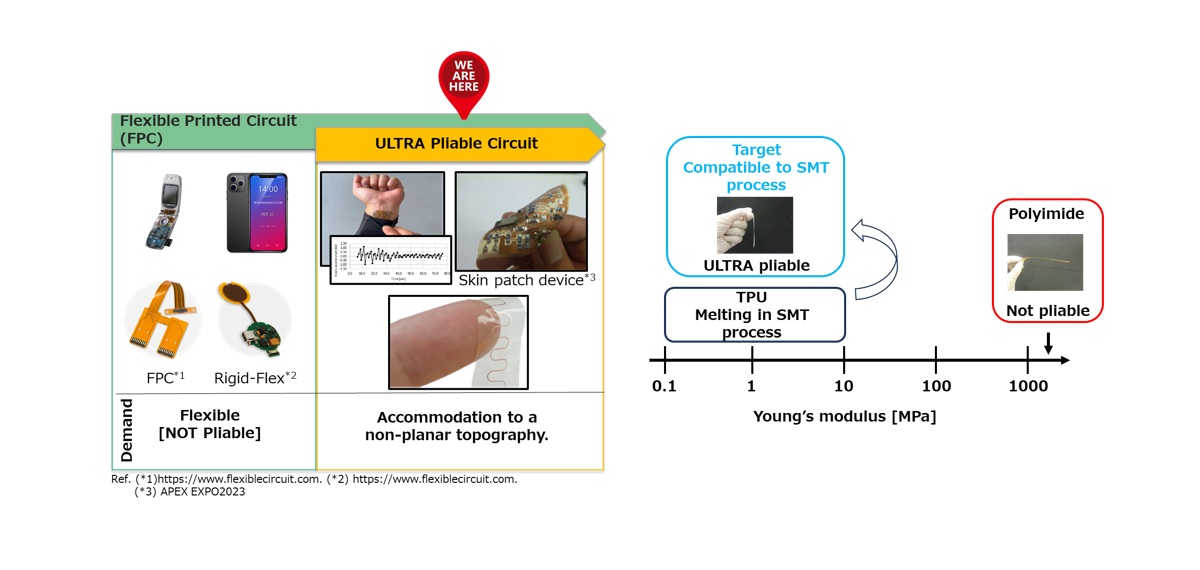Ultra-pliable circuit board technology
Flexible printed circuit boards (FPCs) have found uses in a wide variety of applications, including health/wellness, mobile devices, aerospace, and many more.
Conventional FPCs consist of copper patterns formed on the surface of a flexible film using standard subtractive printed circuit board fabrication processes. Historically, polyimide resin (PI) has been widely used because it is readily available and possesses heat-resistant properties which make it compatible with high-volume assembly processes like solder reflow. However, new applications and device designs like wearables are driving the development of more conformable circuits. Stiff, high-modulus films such as polyimide are not suitable for these products. Currently available pliable, low modulus films like thermoplastic polyurethane (TPU) are not compatible with conventional surface mount (SMT) assembly processes. Researchers at Panasonic Electronic Materials are developing a new material technology that overcomes the limitations of these conventional FPCs.
 Fig1. Comparison of existing FPC materials (polyimide and TPU) and a target ULTRA pliable circuit board
Fig1. Comparison of existing FPC materials (polyimide and TPU) and a target ULTRA pliable circuit board
Kyosuke Michigami, Panasonic Industry Co., Ltd further explores.
Development of Copper Clad Stretch (CCS)
To address the limitations imposed by (1) the stiffness of polyimide and (2) the poor heat durability of TPU, the researchers developed an innovative approach using a copper-clad pliable and stretchable thermosetting resin. This construction is abbreviated CCS for Copper Clad Stretch technology; meaning it can be stretched, unlike conventional copper clad laminates (CCLs). The same resin system is used for both the circuitry layer and the insulative coverlay. The coverlay construction consists of a PET protective film, uncured resin, and polyimide release liner. The unique thermosetting polymer technology can be used in both fully-cured and un-cured format depending on the application. The polyimide release liner in the coverlay also acts as a mechanical support for the soft circuit board during SMT process discussed later in the paper.
 Fig2. Product portfolio achieved with thermosetting polymer technology
Fig2. Product portfolio achieved with thermosetting polymer technology
Heat durability
Assuming exposure to typical SAC (Tin-Silver-Copper alloy) reflow conditions in the SMT process, the researchers conducted a solder float test at 288°C for 10 seconds and confirmed that no blistering or delamination of the CCS occurred (Fig.3). And the bare film made by etching CCS showed pliability and stretchability even after the solder float. On the other hand, TPU which is a thermoplastic resin, melted almost instantaneously and turned out to be incompatible with this SMT process.
 Fig3. Heat durability test (solder float)
Fig3. Heat durability test (solder float)
Mechanical properties
The resin of CCS is much more pliable than polyimide, leading to accommodation of various device form factors such as twisting and bending (Fig.4). Therefore, it is well-suited for non-planar and dynamic applications in healthcare, wearables, and the like.
 Fig4. Various form factors achieved with CCS resin
Fig4. Various form factors achieved with CCS resin
A 10%-stretch cycle test for 10,000 cycles was conducted using a serpentine-patterned CCS (Fig.5). The sample finished the test without any failures in copper pattern. That means CCS has durability for stretch and is suitable for application requiring movements.
 Fig5. Stretch cycle test of serpentine patterned CCS
Fig5. Stretch cycle test of serpentine patterned CCS
CCS compatibility with standard FPC fabrication processes
CCS was evaluated for standard PCB double-sided processes compatibility which consist of mechanical drilling, wet desmear, plating, chemical etching, coverlay patterning-moulding, and surface mounting technology (SMT). The CCS could pass through the process. The polyimide release liner in the coverlay acted as a support structure for avoiding deformation during SMT.
 Fig6. Circuit fabrication process
Fig6. Circuit fabrication process
Conclusion
This new CCS technology exhibits pliability and stretchability not possible with polyimide FPC products. Because of the temperature-resistant thermosetting resin system, CCS is compatible with reflow in the SMT process that TPU cannot withstand. As a result, CCS can be a foundational technology for building more pliable, conformable, and even stretchable devices utilising conventional FPC manufacturing processes.
As a use case of CCS, a reconfigurable intelligent surface (RIS) has been developed by researchers in Osaka University to effectively deliver the radio waves in 6G band (Fig.7, Ref.1). The radio waves at these frequencies are easily blocked by buildings and other physical structures. Researchers in Osaka University fabricated a metasurface reflector that can be attached to various locations and whose angle can be adjusted by expanding and contracting. By the combining a metasurface pattern and the inherent stretchability of CCS, it is possible to reflect radio waves efficiently.
 Fig7. Reconfigurable anomalous reflector fabricated on a stretchable elastic substrate. (a) Photograph of a prototype. (b) Schematic of a dynamic control of the reflection direction. (c) Photograph of a stretched sample mounted on a fixture. (d) Photographs of the sample before and after a stretch
Fig7. Reconfigurable anomalous reflector fabricated on a stretchable elastic substrate. (a) Photograph of a prototype. (b) Schematic of a dynamic control of the reflection direction. (c) Photograph of a stretched sample mounted on a fixture. (d) Photographs of the sample before and after a stretch
In addition to the research noted above, there are many product development projects in progress using the CCS technology. Panasonic Industry is proceeding with the development of CCS technology together with our customers and preparing for mass production.



